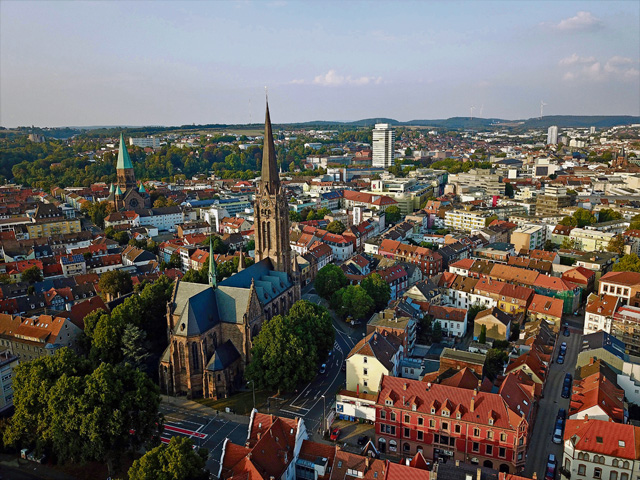
The best-preserved memory of Jewish life in Kaiserslautern during the Middle Ages is a ritual mikveh which was found in 1995 during excavation work near the Sparkasse bank building at Altenhof. The bath is 2.40 x 2.50 meters in size and embedded into the sandstone, which still has ground water inflow. After the Jewish community was driven out of the city in 1398, the bath was filled up. The former mikveh is now well preserved and can be visited on guided tours.
After 1800 and under French rule, numerous families from surrounding villages moved back into the city. The Jewish community quickly grew and by 1883 it had 716 members, who mainly lived in or near Judengasse next to today’s Altenhof. Some of its members chose to reside in nearby Mehlingen or Otterberg. The community then decided that it was time to construct a new synagogue for its growing population.
Professor Ludwig Levy of Karlsruhe was commissioned to design the sacral building with a large tambour style cupola in a Moorish-Byzantian style. The foundation stone was laid on Oct. 29, 1883, 140 years ago.
The building was constructed in the shape of a Greek cross, walls were ornamentally decorated and countless tiny windows let in sunlight to give the interior a majestic glow. The magnificent building was opened in a grand ceremony on Feb. 26, 1886, making it one of Kaiserslautern’s most majestic edifices with an unusual oriental touch. It was also noted as being the largest and most beautiful synagogue in Germany.
Due to the increasing influence of the National Socialistic regime, only 648 Jewish residents lived in the city by 1933, with merely 90 persons remaining by 1939.
The magnificent synagogue was located on Fischerstrasse (at that time Dr.-Frick-Strasse) and the city intended to use the road for military parades. The lord mayor of the time used this as an excuse to remove the structure, in his eyes seen as non-fitting into Kaiserslautern’s architecture, and in an effort to widen the road.
The last Jewish worship took place in August 1938 and the beautiful building started being dismantled on Aug. 29, while the remaining parts were eventually blown up during the fall of the same year.
In 1980, forty-two years after the destruction, the City of Kaiserslautern declared the former location as Synagogenplatz with a memorial stone. In addition, in the year 2001 the original foundation of the northern portal was excavated.
A memorial site with two seven-meter-high pillar fragments made of red and yellow sandstone, resembling the building material of the original structure, was constructed. The wall facing the former synagogue is engraved with 192 names of Holocaust victims and the opposite side shows the original layout of the structure when the site was opened in 2003.
Since 2006 the memorial has been equipped with seven media viewers that reconstruct the interior with 3-D animations, created by the Technical University Darmstadt, and offer a virtual view of the ornamental synagogue.
The community “Jüdische Kultusgemeinde Rheinland-Pfalz” has centers in Kaiserslautern, Ludwigshafen and Speyer. For details, visit: https://www.jkgrp.de
The Museum Pfalzgalerie in Kaiserslautern is showcasing a special exhibit with works of expressionist painter Rudolf Levy (1875-1944) for the first time in Germany. Levy was born in Germany, lived in New York for a few years, and became known as the “artist of color.” He later became a victim of the Holocaust. In his honor the museum is hosting the exhibiton from Oct. 28 – Nov. 2. For details visit: https://mpk.de/sonderausstellungen/


